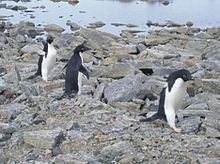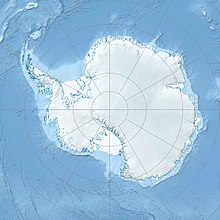Schirmacher oasis
Coordinates: 70 ° 45 ′ 0 ″ S , 11 ° 40 ′ 0 ″ E

The Schirmacher Oasis (also Schirmacher Lake District) is a 25 km long and up to 3 km wide, snow and ice-free hill plateau with over 100 freshwater lakes on the Princess Astrid Coast in Queen Maud Land in East Antarctica . The area of this Antarctic oasis, which is the smallest with an area of 34 km², is a typical coastal frost rubble desert for East Antarctica .
geography
The 100 m high plateau of the Schirmacher Oasis, located between the Novolasarewskaya ( Nivl ) ice shelf and the inland ice , forms a barrier for the inland ice current flowing northwards. At the northern edge of the oasis there are so-called Epi-Ice Shelf Lakes, sea bays separated from the ocean, which, because of their connections with the ocean under the ice, have marine ponds. The Epi-Ice Shelf lakes can contain both pure freshwater and seawater overlaid by freshwater. The inland ice south of the Schirmacher Oasis reaches heights of 1500 m. The Nunatak groups Skaly Instituta Geologii Arktiki (Skaly IGA) and Basisny-Kit protrude beyond the ice sheet. The Wohlthat massif lies between the inland ice near the coast and the Wegener inland ice plateau .
The highest elevation in the Schirmacher Oasis is the Rebristajaberg with a height of 228 m. At 34.5 m, Lake Glubokoje is the deepest inland lake in the Schirmacher Oasis. Lake Sub is the largest lake in the oasis with an area of 0.5 km² .
climate
The Schirmacher Oasis has a mild climate by Antarctic standards; the mean annual temperature is −10.4 ° C, the mean annual wind speed 9.7 m / s, the mean annual precipitation 264.5 mm, there are 350 hours of sunshine per month. Taking into account the positive radiation balance, the climate of the Schirmacher Oasis is regionally classified in the zone of the coastal climate.
fauna and Flora
The rocky subsoil offers a habitat for some undemanding plants such as mosses and lichens. Animal life in the oasis is rare. Exceptions are the Antarctic skua , the Antarctic petrel , the snow petrel and the spotted petrel . Occasionally, Adelie penguins visit the Schirmacher Oasis.
history
The German Antarctic Expedition of 1939 under the command of Captain Alfred Ritscher used two flying boats of the type Dornier Wal , of the catapult ship Swabia were launched to aerial flights. The captain of the flying boat “Boreas”, Richardheinrich Schirmacher (1909–?), Discovered the oasis named after him and the Wohlthat massif from an airplane on February 3, 1939.
Novolazarevskaya Station
On March 10, 1959, the Soviet Union built the Lasarew research station on the ice shelf in the region of the Schirmacher Oasis. The station was moved to the oasis itself in 1961 and was named Novolasarewskaya . The maximum occupation of the station is up to 70 people in summer. In winter, an average of 30 scientists and technicians work in Novolazarevskaya Station. The scientific research includes the fields of geodesy , glaciology , limnology , geomagnetics , geology , biology , meteorology , seismology and other specialist areas.
Georg Forster Station
About 2 km from the Russian station Novolasarewskaja, was on April 21, 1976 at about 120 m. ü. M. opened the first German research base in the Antarctic, the Georg Forster Station . In 1987 the station operated by the GDR was named after the naturalist Georg Forster . In particular, the station's ozone measurements received international recognition. More than 100 scientists worked there during the 17-year existence of the Georg Forster Station. The scientific operation of the Forster station ceased in February 1993. From 1993 to 1996 the station was completely dismantled and disposed of. After the dissolution of the Eastern Bloc, parts of the Schirmacher Oasis were among the most polluted regions in Antarctica. Polar researchers from the Alfred Wegener Institute for Polar and Marine Research in Bremerhaven and from the Arctic and Antarctic Research Institute in Saint Petersburg removed 1,016 tons of scrap and waste from the former GDR polar station and from the Russian station Novolasarewskaja.
Maitri station
In 1981 India also launched an Antarctic program. In 1983 the “Dakshin Gangotri” ice shelf station was built about 10 km away from the Schirmacher Oasis. In 1989 it had to be abandoned due to constant drifts. In 1988 the Maitri station was built in the Schirmacher Oasis, about 5 km from Novolasarewskaya. Maitri has a meteorological station as well as a geomagnetic and seismological observation center and offers space for up to 26 scientists and technicians.
literature
- W. Korth, J. Perlt, R. Dietrich: Results of geodetic-glaciological field work during the 1998 expedition in the region of the umbrella oasis. In: R. Dietrich (ed.): German contributions to GPS campaigns of the Scientific Committee on Antarctic Research (SCAR) 1995–1998. (= German Geodetic Commission. Series B, Issue 310). Munich 2000, ISBN 3-7696-8590-3 .
- SK Bera, A. Khandewala: Aerospora over Southern Ocean and Schirmacher oasis. In: East Antarctica Current Science. Volume 85, No. 2, 2003, pp. 137-140. (PDF) ( Memento from March 19, 2004 in the Internet Archive )
Web links
- Martin Melles, Sabrina Ortlepp: Late Quaternary environmental and climate history of the East Antarctic . Institute for Geophysics and Geology at the University of Leipzig.
- G. Öchsle: Cleaning up the pack ice. In: FOCUS. No. 18, 1996.
- Work card geographical names in the area of the GEOMAUD expedition 1995/96, Schirmacherseenplatte 1: 100,000. (PDF file; 1.1 MB).
Individual evidence
- ^ Directory of German geographic names of the Antarctic. Version 2.14, Federal Agency for Cartography and Geodesy, June 13, 2014.
- ^ W. Richter, P. Bormann: Weather and climate. The Schirmacher Oasis, Queen Maud Land, East Antarctica, and its Surroundings. Gotha 1995.
- ↑ Ulf: Rocky island in the ice. ( Memento of April 21, 2007 in the Internet Archive ) (PDF; 2.2 MB). In: atkaXpress. 35th edition, January 2003, pp. 9-10. Foundation Alfred Wegener Institute for Polar and Marine Research in the Helmholtz Association


